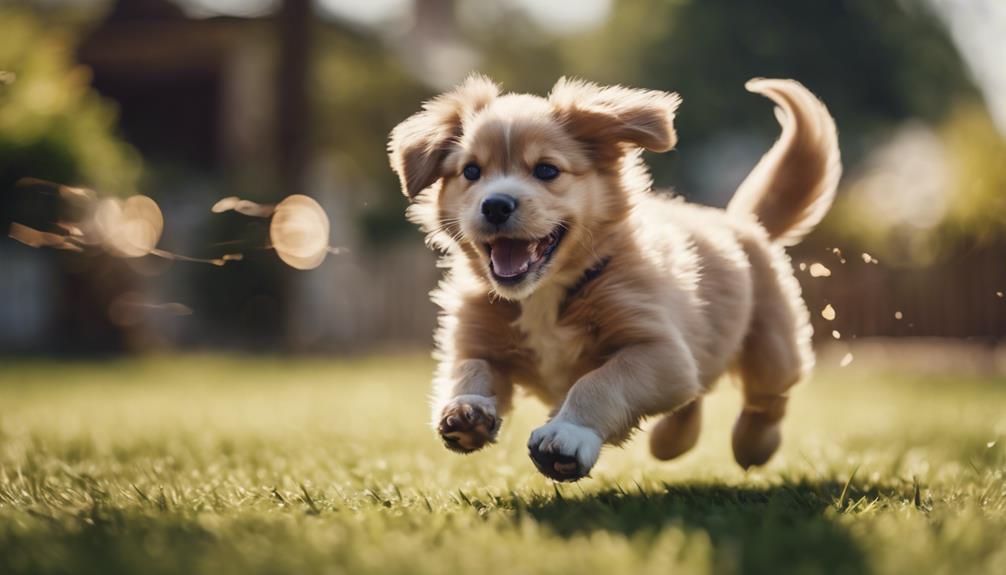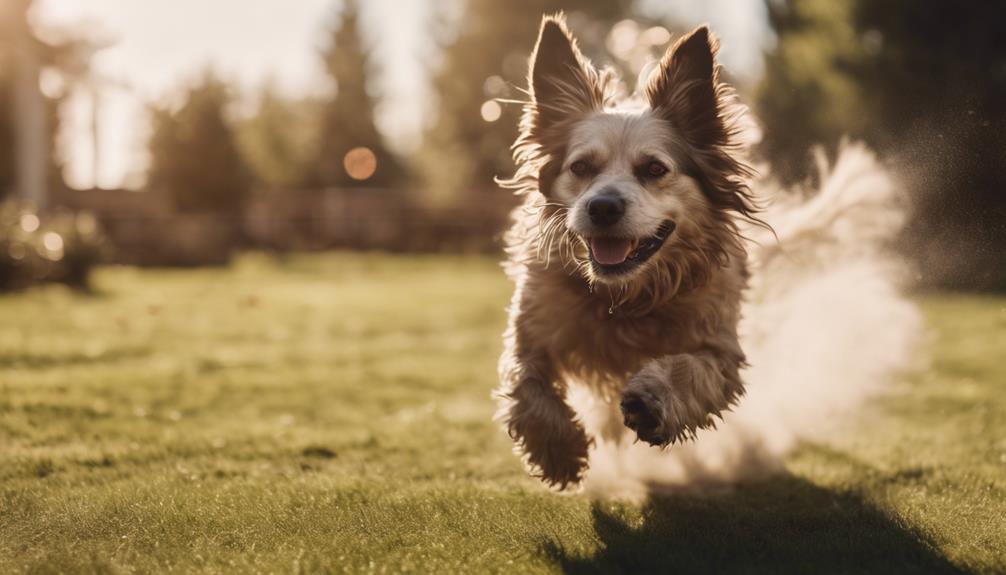Canine enthusiasts have long been intrigued by the enigmatic behavior of dog zoomies, those moments of seemingly uncontrollable energy bursts that captivate both pets and their owners.
While these frenzied displays may appear random, they are rooted in a combination of physiological and psychological factors that shape our understanding of canine behavior.
By unraveling the underlying reasons behind why dogs go bonkers on occasion, we can gain a deeper appreciation for the intricate ways in which our furry companions interact with the world around them.
Key Takeaways
- Zoomies help dogs release pent-up energy and cope with stress and excitement.
- Dogs of all ages and breeds experience zoomies for various reasons.
- Zoomies can serve as a warm-up, celebration, instinctual response, or excitement indicator.
- Dogs exhibit zoomies to express joy, enthusiasm, and to show their emotions in a fun and entertaining way.
Physical and Mental Stimulation
Physical and mental stimulation play a crucial role in ensuring dogs' overall well-being and behavior. Dogs require a balance of both physical exercise and mental engagement to maintain a healthy lifestyle.
Regular physical activity, such as walks, runs, or playtime, helps in burning excess energy, preventing obesity, and promoting cardiovascular health. On the other hand, mental stimulation through interactive toys, training sessions, or puzzle games is essential for keeping their minds sharp and preventing boredom-induced behavioral issues like destructive chewing or excessive barking.
A lack of proper stimulation can lead to pent-up energy, anxiety, and frustration, potentially triggering behaviors like zoomies as a way for dogs to release built-up tension and cope with stress.
Excessive Energy Release
Proper mental stimulation is crucial in preventing excessive energy release in dogs, which can manifest in behaviors like zoomies as a way for them to cope with pent-up tension and stress. When dogs do not receive adequate mental stimulation, they may resort to excessive energy release through activities like zoomies. This behavior can be a signal that your dog needs more mental engagement to prevent such outbursts.
To address excessive energy release in dogs effectively, consider the following strategies:
- Interactive Toys: Providing toys that challenge your dog mentally can help redirect their excess energy.
- Training Sessions: Engaging in regular training sessions can stimulate your dog's mind and prevent the buildup of excessive energy.
- Enrichment Activities: Incorporating enrichment activities like puzzle feeders or scent games can keep your dog mentally engaged and reduce the likelihood of excessive energy release.
Age and Energy Levels

Understanding the correlation between a dog's age and energy levels provides valuable insights into their behavioral patterns and activity requirements. Puppies and young dogs typically have higher energy levels compared to older dogs. This abundance of energy often manifests in frequent bursts of activity and zoomies.
As dogs age, their energy levels tend to decrease, leading to a decrease in the frequency and intensity of zoomies. It is essential for dog owners to recognize and accommodate these age-related changes in energy levels by adjusting their exercise routines and mental stimulation activities accordingly.
Coping With Stress and Anxiety
In addressing stress and anxiety in dogs, it is crucial for pet owners to recognize behavioral cues and implement appropriate strategies for support.
Here are three ways to help dogs cope with stress and anxiety:
- Create a Calm Environment: Provide a safe and quiet space where your dog can retreat when feeling anxious. Use calming aids like music or pheromone diffusers to reduce stress levels.
- Regular Exercise and Mental Stimulation: Engage your dog in daily physical activities and mental exercises to help release excess energy and promote relaxation. This can include interactive toys, obedience training, or puzzle games.
- Consistent Routine and Positive Reinforcement: Establish a predictable schedule for feeding, walks, and playtime to reduce anxiety. Use positive reinforcement techniques to reward calm behavior and build confidence.
Temperature Regulation and Warm-Up

Temperature regulation and warm-up are essential aspects of a dog's physical well-being, especially after engaging in activities involving water or exposure to varying temperatures. Dogs may exhibit zoomies to warm up after walks, regulate body temperature post-bath, adjust to different temperatures by running around, especially after activities involving water or cold weather. This behavior helps dogs feel comfortable and regulate their body heat efficiently.
| Temperature Regulation and Warm-Up | |
|---|---|
| After Walks | Regulates body temperature |
| Post-Bath Zoomies | Helps regulate body heat |
| Adjusting to Temperatures | Running around to regulate temperature |
| After Water Activities | Helps dogs feel comfortable |
Celebratory and Instinctual Reactions
A common behavior seen in dogs, especially after moments of relief or joy, is the exuberant display known as 'zoomies.'
Celebratory and Instinctual Reactions are key reasons behind this behavior:
- Celebratory Reactions:
- Dogs may exhibit zoomies after relieving themselves, such as after pooping.
- Zoomies can be a celebratory reaction, expressing joy and satisfaction.
- Running around post-relief can signify a sense of relief and happiness.
- Instinctual Responses:
- Zoomies often coincide with specific periods during the day, linked to dogs' biological rhythms.
- Dogs' burst of energy in the morning and evening may be tied to primal hunting cycles.
- Expressing joy and enthusiasm, zoomies can also be a reaction to excitement, including seeing special people or other dogs.
Could Dog Zoomies Be a Sign of Congestive Heart Failure in Dogs?
Dog zoomies can indicate a pet’s joy and energy. However, excessive zoomies might be a warning sign of congestive heart failure in dogs. It is essential to seek immediate congestive heart failure dogs treatment to manage the condition and ensure the well-being of your furry friend.
Conclusion
In conclusion, the phenomenon of dog zoomies, or frenetic random activity periods, can be attributed to various factors such as:
- Physical and mental stimulation
- Excessive energy release
- Age and energy levels
- Coping with stress and anxiety
- Temperature regulation
- Celebratory and instinctual reactions
Understanding these reasons can provide valuable insights into the behavior of our canine companions and help us better care for their physical and emotional well-being.




